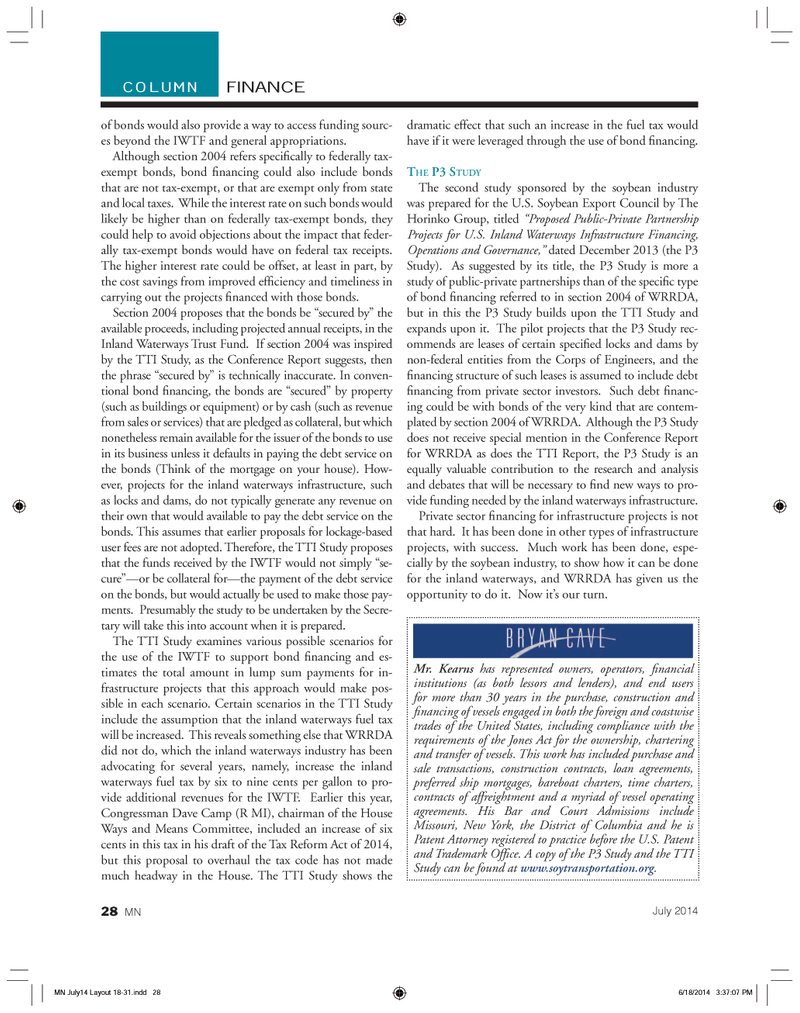
Page 28: of Marine News Magazine (July 2014)
ATB Technical Trends
Read this page in Pdf, Flash or Html5 edition of July 2014 Marine News Magazine
of bonds would also provide a way to access funding sourc- es beyond the IWTF and general appropriations. Although section 2004 refers speciÞ cally to federally tax- exempt bonds, bond Þ nancing could also include bonds that are not tax-exempt, or that are exempt only from state and local taxes. While the interest rate on such bonds would likely be higher than on federally tax-exempt bonds, they could help to avoid objections about the impact that feder- ally tax-exempt bonds would have on federal tax receipts. The higher interest rate could be offset, at least in part, by the cost savings from improved efÞ ciency and timeliness in carrying out the projects Þ nanced with those bonds. Section 2004 proposes that the bonds be Òsecured byÓ the available proceeds, including projected annual receipts, in the Inland Waterways Trust Fund. If section 2004 was inspired by the TTI Study, as the Conference Report suggests, then the phrase Òsecured byÓ is technically inaccurate. In conven- tional bond Þ nancing, the bonds are ÒsecuredÓ by property (such as buildings or equipment) or by cash (such as revenue from sales or services) that are pledged as collateral, but which nonetheless remain available for the issuer of the bonds to use in its business unless it defaults in paying the debt service on the bonds (Think of the mortgage on your house). How- ever, projects for the inland waterways infrastructure, such as locks and dams, do not typically generate any revenue on their own that would available to pay the debt service on the bonds. This assumes that earlier proposals for lockage-based user fees are not adopted. Therefore, the TTI Study proposes that the funds received by the IWTF would not simply Òse- cureÓÑor be collateral forÑthe payment of the debt service on the bonds, but would actually be used to make those pay-ments. Presumably the study to be undertaken by the Secre- tary will take this into account when it is prepared. The TTI Study examines various possible scenarios for the use of the IWTF to support bond Þ nancing and es- timates the total amount in lump sum payments for in-frastructure projects that this approach would make pos- sible in each scenario. Certain scenarios in the TTI Study include the assumption that the inland waterways fuel tax will be increased. This reveals something else that WRRDA did not do, which the inland waterways industry has been advocating for several years, namely, increase the inland waterways fuel tax by six to nine cents per gallon to pro- vide additional revenues for the IWTF. Earlier this year, Congressman Dave Camp (R MI), chairman of the House Ways and Means Committee, included an increase of six cents in this tax in his draft of the Tax Reform Act of 2014, but this proposal to overhaul the tax code has not made much headway in the House. The TTI Study shows the dramatic effect that such an increase in the fuel tax would have if it were leveraged through the use of bond Þ nancing. THE P3 STUDY The second study sponsored by the soybean industry was prepared for the U.S. Soybean Export Council by The Horinko Group, titled ?Proposed Public-Private Partnership Projects for U.S. Inland Waterways Infrastructure Financing, Operations and Governance,? dated December 2013 (the P3 Study). As suggested by its title, the P3 Study is more a study of public-private partnerships than of the speciÞ c type of bond Þ nancing referred to in section 2004 of WRRDA, but in this the P3 Study builds upon the TTI Study and expands upon it. The pilot projects that the P3 Study rec- ommends are leases of certain speciÞ ed locks and dams by non-federal entities from the Corps of Engineers, and the Þ nancing structure of such leases is assumed to include debt Þ nancing from private sector investors. Such debt Þ nanc-ing could be with bonds of the very kind that are contem- plated by section 2004 of WRRDA. Although the P3 Study does not receive special mention in the Conference Report for WRRDA as does the TTI Report, the P3 Study is an equally valuable contribution to the research and analysis and debates that will be necessary to Þ nd new ways to pro- vide funding needed by the inland waterways infrastructure. Private sector Þ nancing for infrastructure projects is not that hard. It has been done in other types of infrastructure projects, with success. Much work has been done, espe- cially by the soybean industry, to show how it can be done for the inland waterways, and WRRDA has given us the opportunity to do it. Now itÕs our turn. FINANCECOLUMNMr. Kearns has represented owners, operators, nancial institutions (as both lessors and lenders), and end users for more than 30 years in the purchase, construction and nancing of vessels engaged in both the foreign and coastwise trades of the United States, including compliance with the requirements of the Jones Act for the ownership, chartering and transfer of vessels. This work has included purchase and sale transactions, construction contracts, loan agreements, preferred ship mortgages, bareboat charters, time charters, contracts of affreightment and a myriad of vessel operating agreements. His Bar and Court Admissions include Missouri, New York, the District of Columbia and he is Patent Attorney registered to practice before the U.S. Patent and Trademark Of ce. A copy of the P3 Study and the TTI Study can be found at www.soytransportation.org .July 201428 MNMN July14 Layout 18-31.indd 28MN July14 Layout 18-31.indd 286/18/2014 3:37:07 PM6/18/2014 3:37:07 PM

 27
27

 29
29
